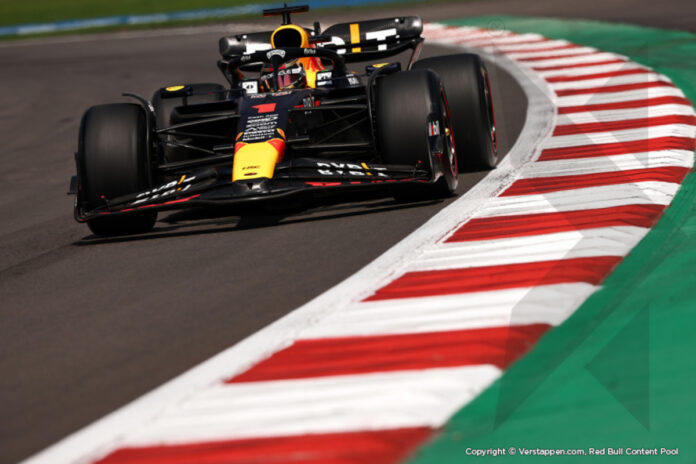Max Verstappen
The events unfolding in the Formula 1 season, particularly during the Mexico City Grand Prix practice session, highlight several key points and continue the excitement and unpredictability that F1 is known for.
- Max Verstappen set the fastest time in FP1 for the Mexico City Grand Prix, ahead of Alex Albon and Sergio Perez.
- Three rookies made their F1 debuts in FP1: Ollie Bearman (Haas), Isack Hadjar (AlphaTauri), and Frederik Vesti (Mercedes).
- Bearman was the fastest of the rookies, finishing 15th.
- Technical problems plagued the session, with Carlos Sainz, Lando Norris, Charles Leclerc, and Fernando Alonso all experiencing issues.
- Theo Pourchaire had a luckless FP1 outing for Alfa Romeo, with a brake-by-wire issue restricting him to just four laps.
Here’s an analysis and breakdown of the significant moments and what they could mean for the teams and drivers involved:
- Verstappen’s Performance: Max Verstappen leading the timesheets isn’t a surprise given his championship-calibre performances. Being at the top in FP1 gives a psychological edge, but it’s essential to note that practice sessions are about fine-tuning the setup and getting comfortable with the track conditions. However, his pace sets a precedent and shows that Red Bull is, once again, competitive on a track where managing tyres and downforce levels are crucial.


Alex Albon and Sergio Perez
- Albon’s Impressive Show: Alex Albon making it to the top tier of the timesheets in a Williams is noteworthy. It shows personal growth and adaptability, given his past experiences with Red Bull. This performance might play a crucial role in his F1 career, indicating his potential to teams for future seats and possibly solidifying his position in Williams or putting him on the radar for other teams.
Rookie F1 debuts
- Rookies On The Grid: The debut of rookies like Ollie Bearman, Isack Hadjar, Jack Doohan, and Frederik Vesti is significant. FP1 sessions are critical for young drivers to showcase their skills, adaptability, and potential for race or test seats. Their performances, particularly under the pressure of an F1 weekend, are closely watched by teams and the media. These sessions often influence decisions regarding future driver line-ups, and strong performances can fast-track careers.
Technical problems
- Technical Glitches: The technical issues faced by prominent drivers like Carlos Sainz, Lando Norris, and Charles Leclerc emphasize the challenging aspect of F1 machinery. These glitches during practice sessions are wake-up calls for teams to rectify issues before qualifying and the race. They also show how every minute of track time is valuable for gathering data and understanding the car’s behavior.
- Hamilton’s Position: Lewis Hamilton finishing 11th in FP1 shouldn’t be a significant cause for concern for Mercedes as practice sessions are used for various strategies and setups, not always focusing on outright speed. However, it emphasizes the competitive nature of this season and shows that the team has work to do, especially considering the close championship battle.
Brake-by-wire issue
- Alonso’s Setback: Fernando Alonso’s limited running time is unfortunate, as track time is precious for setting up the car and strategy planning. It shows that even experienced teams and drivers face hurdles and that the technical side of F1 is always unpredictable.
- Focus on Youth: The presence of young drivers shows F1’s commitment to nurturing new talent, providing valuable experience, and assessing young drivers in competitive environments. It’s a crucial aspect of the sport’s sustainability and future.
Practice Results
| Pos | Driver | Team | Time | Gap | Laps |
|---|---|---|---|---|---|
| 1 | Max Verstappen | Red Bull Racing Honda RBPT | 1:19.718 | 29 | |
| 2 | Alexander Albon | Williams Mercedes | 1:19.813 | +0.095s | 30 |
| 3 | Sergio Perez | Red Bull Racing Honda RBPT | 1:20.015 | +0.297s | 27 |
| 4 | Lando Norris | McLaren Mercedes | 1:20.237 | +0.519s | 29 |
| 5 | Charles Leclerc | Ferrari | 1:20.297 | +0.579s | 29 |
| 6 | Oscar Piastri | McLaren Mercedes | 1:20.463 | +0.745s | 31 |
| 7 | Carlos Sainz | Ferrari | 1:20.479 | +0.761s | 22 |
| 8 | Daniel Ricciardo | AlphaTauri Honda RBPT | 1:20.568 | +0.850s | 30 |
| 9 | Esteban Ocon | Alpine Renault | 1:20.677 | +0.959s | 26 |
| 10 | Lance Stroll | Aston Martin Mercedes | 1:20.687 | +0.969s | 26 |
| 11 | Lewis Hamilton | Mercedes | 1:20.724 | +1.006s | 24 |
| 12 | Nico Hulkenberg | Haas Ferrari | 1:20.968 | +1.250s | 28 |
| 13 | Zhou Guanyu | Alfa Romeo Ferrari | 1:21.129 | +1.411s | 26 |
| 14 | Logan Sargeant | Williams Mercedes | 1:21.157 | +1.439s | 30 |
| 15 | Oliver Bearman | Haas Ferrari | 1:21.313 | +1.595s | 30 |
| 16 | Fernando Alonso | Aston Martin Mercedes | 1:21.347 | +1.629s | 17 |
| 17 | Isack Hadjar | AlphaTauri Honda RBPT | 1:21.941 | +2.223s | 25 |
| 18 | Jack Doohan | Alpine Renault | 1:22.109 | +2.391s | 24 |
| 19 | Frederik Vesti | Mercedes | 1:22.937 | +3.219s | 25 |
| 20 | Theo Pourchaire | Alfa Romeo Ferrari | — | 4 |
In conclusion, the FP1 session at the Mexico City GP has set the stage for an exciting weekend of racing, with various narratives from emerging rookies, technical challenges, and the ongoing battle for supremacy among the top contenders. As always, these elements remind fans and participants of the sport’s unpredictability and the ever-present need for teams and drivers to adapt and overcome.
News Verstappen
Images Copyright of Verstappen and Red Bull




































